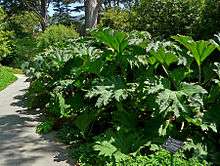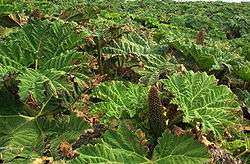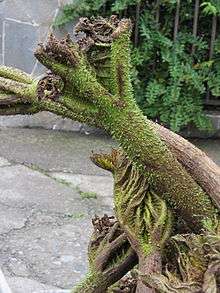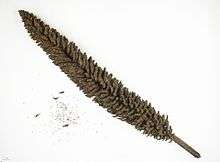Gunnera tinctoria
Gunnera tinctoria, known as giant rhubarb[1] or Chilean rhubarb, is a flowering plant species native to southern Chile and neighbouring zones in Argentina. It is unrelated to rhubarb, as the two plants belong into different orders, but looks similar from a distance and has similar culinary uses. It is a large-leaved perennial plant that grows to more than two metres tall. It has been introduced to many parts of the world as an ornamental plant and in some countries (for instance New Zealand, Great Britain and Ireland) it has spread from gardens and is becoming a weed problem. It is known under the synonyms: Gunnera chilensis Lam. and Gunnera scabra Ruiz & Pav.
| Gunnera tinctoria | |
|---|---|
 | |
| Scientific classification | |
| Kingdom: | Plantae |
| Clade: | Tracheophytes |
| Clade: | Angiosperms |
| Clade: | Eudicots |
| Order: | Gunnerales |
| Family: | Gunneraceae |
| Genus: | Gunnera |
| Species: | G. tinctoria |
| Binomial name | |
| Gunnera tinctoria (Molina) Mirbel. | |
Description
Gunnera tinctoria is a giant, clump-forming herbaceous perennial. The leaves can grow up to 2.5m across, cordate and palmate with up to 9-lobed margins.[2] It has erect spikes of cone-shaped inflorescences (to 1m) from spring to early summer, with small flowers. The fruit is orange. The number of seeds is estimated from 80,000 per seedhead to 250,000 per plant.

Habitat
Stream and roadsides.[2]
Uses
In its native Chile, where it is called nalca or pangue, it is used in a similar way to European rhubarb: the stalks are eaten fresh or cooked into jam or cordial. The leaves are used in the preparation of the traditional Chilean dish curanto.
As an invasive species
In parts of New Zealand the Chilean rhubarb has become a recognised pest plant. For instance in Taranaki, on the west coast of the North Island it was spread to riverbeds, coastal cliffs and forest margins.[3] G. tinctoria is on the National Pest Plant Accord. Under Section 52 and 53 of the Biosecurity Act, it is an offence to knowingly propagate, distribute, spread, sell, offer for sale.[4] In Great Britain it has become well-established and sometimes problematic in western districts and appears to be spreading.[5] In the west of Ireland, G. tinctoria is a major invasive species,[6] in particular on Achill Island and on Corraun Peninsula, County Mayo. Its large leaves create dense shade, preventing other species from germinating or growing. Chilean rhubarb is classified in the European Union as an invasive species of Union concern, and it is illegal to import, grow, possess or sell it within the EU.[7]


Similar species
A similar species is Gunnera manicata (Brazilian giant rhubarb). This species may also be invasive.
In popular culture
In October of 2019, photos of a produce vendor in Puerto Montt dressing himself in nalca leaves began circulating on Chilean social media under the name "Nalcaman".[8] Because these photos were being shared around the same time as the beginning of the 2019–20 Chilean protests, Nalcaman has since become an element of the iconography surrounding Chile's anti-government protests.[9]

Notes
The blue-green alga Nostoc is a symbiont in Gunnera.[6]
References
- "BSBI List 2007". Botanical Society of Britain and Ireland. Archived from the original (xls) on 2015-01-25. Retrieved 2014-10-17.
- Parnell, J. and Curtis, T. 2012. Webb's An Irish Flora Cork University Press ISBN 978-185918-4783
- Giant problems for Taranaki Archived 2007-10-19 at the Wayback Machine; especially the pictures of Gunnera tinctoria on seacliffs (p. 17)
- Department of Conservation 2005, p. 3
- Anon. "Giant Rhubarb, Gunnera tinctoria". NNSS species information. GB Non-native species secretariat. Retrieved 1 May 2017.
- Guiry, M.D., John, D.M., Rindi, F and McCarthy, T.K. (eds) 2007. New Survey of Clare Island 6: The Freshwater and Terrestrial Algae. Royal Irish Academy. ISBN 978-1-904890-31-7
- Anon. "List of Invasive Alien Species of Union concern". European Commission. Retrieved 18 June 2019.
- 24horas.cl. "Nalcaman: El nuevo superhéroe de Puerto Montt que encantó a las redes sociales" 24horas.cl, Santiago, 4 October 2019. Retrieved on 10 February 2020.
- The Clinic. "Fotos épicas: Todos los superhéroes que han aparecido en las protestas en Chile" The Clinic, Santiago, 6 November 2019. Retrieved on 10 February 2020.
Literature
- Pink, A. (2004). Gardening for the Million. Project Gutenberg Literary Archive Foundation.
- Department of Conservation (NZ) - Plant me instead. Wellington (New Zealand) 2005. ISBN 0-478-14007-X
- Department of Conservation - leaflet: "Chilean Rhubarb; shading out our natives", Wanganui. March 2006.
External links
| Wikimedia Commons has media related to Gunnera tinctoria. |
- Gunnera tinctoria
- Gunnera tinctoria at Biosecurity New Zealand
- images